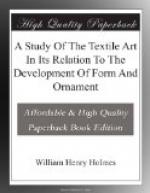[Illustration: FIG. 347. Figure of a bird woven in interlaced wicker at one side of the center.]
It is clear, therefore, from the preceding observations that the convention of woven life forms varies with the kind of weaving, with the shape of the object, with the position upon the object, and with the shape of the space occupied, as well as with the inherited style of treatment and with the capacity of the artist concerned. These varied forces and influences unite in the metamorphosis of all the incoming elements of textile embellishment.
It will be of interest to examine somewhat closely the modifications produced in pictorial motives introduced through superstructural and adventitious agencies.
We are accustomed, at this age of the world, to see needlework employed successfully in the delineation of graphic forms and observe that even the Indian, under the tutelage of the European, reproduces in a more or less realistic way the forms of vegetal and animal life. As a result we find it difficult to realize the simplicity and conservatism of primitive art. The intention of the primitive artist was generally not to depict nature, but to express an idea or decorate a space, and there was no strong reason why the figures should not submit to the conventionalizing tendencies of the art.
I have already shown that embroidered designs, although not from necessity confined to geometric outlines, tend to take a purely geometric character from the fabric upon which they are executed, as well as from the mechanical processes of stitching. This is well shown in Fig. 348, a fine specimen given by Wiener in his work Perou et Bolive.
[Illustration: FIG. 348. Embroidery upon a cotton net in which the textile combinations are followed step by step. Ancient Peruvian work.]
A life form worked upon a net does not differ essentially from the same subject woven in with the web and woof. The reason is found in the fact that in embroidery the workman was accustomed from the first to follow the geometric combination of the foundation fabric step by step, and later in life delination he pursued the same method.
It would seem natural, however, that when the foundation fabric does not exhibit well marked geometric characters, as in compactly woven canvas, the needlework would assume free hand characters and follow the curves and irregularities of the natural object depicted; but such is not the case in purely aboriginal work. An example of embroidery obtained from an ancient grave at Ancon, Peru, is shown in Fig. 349. A piece of brown cotton canvas is embellished with a border of bird figures in bright colored wool thread. The lines of the figures do not obey the web and woof strictly, as the lines are difficult to follow, but the geometric character is as perfectly preserved as if the design were woven in the goods.
[Illustration: FIG. 349. Embroidery in which the foundation fabric is not followed accurately, but which exhibits the full textile geometricity. Ancient Peruvian work.]




